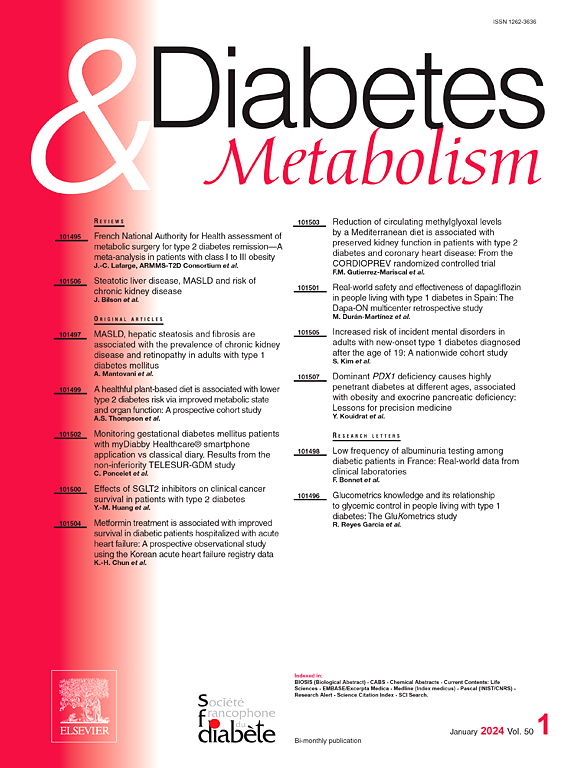Glucose management indicator: Do we need device-specific equations?
IF 4.7
2区 医学
Q1 ENDOCRINOLOGY & METABOLISM
引用次数: 0
Abstract
Aim
Glucose management indicator (GMI) may not perform equally well for different continuous glucose monitoring (CGM) systems. Thus, we aimed to develop device-specific GMI for the Guardian 3 and 4 sensors, compare them to the original GMI, and investigate the association between the glycaemic gap (=HbA1c-GMI) and HbA1c.
Methods
In a single-centre, observational study of adult type 1 diabetes patients using Guardian Sensor 3 (G3) and 4 (G4) CGM devices, we estimated HbA1c using CGM-derived mean glucose for both CGMs using linear mixed models. We compared the estimates and their residuals (G3-gap and G4-gap) to the original GMI and its residuals (Bergenstal-gap) using regression and Bland-Altman plots.
Results
We included 120 adult type 1 diabetes patients (90 with G3 and 30 with G4) and 194 measurement points. We found that for G3 and G4 sensors, GMI significantly underestimated glycaemia in high HbA1c ranges, reaching the clinically significant 0.5 %[4.4 mmol/mol] difference at 7.6 % [60 mmol/mol] for G3 and 8.3 % [67 mmol/mol] for G4 sensors. For G4, GMI significantly overestimated glycaemia in the lower HbA1c range. We found a strong relationship between all 3 gaps and HbA1c, and the slope was steeper for the Bergenstal-gap versus the sensor-specific G3 and G4 gaps. The G3-gap was approximately half as large as the Bergenstal-gap for HbA1c > 7 % [53 mmol/mol], and the G4-gap is approximately half of the Bergenstal-gap for the whole HbA1c range.
Conclusion
Device-specific GMI equations could reduce the risk of clinically significant under- and overestimation of HbA1c, improving clinical decision-making.
葡萄糖管理指标:我们需要设备专用方程式吗?
目的:葡萄糖管理指标(GMI)在不同连续血糖监测(CGM)系统中的表现不尽相同。因此,我们的目标是为Guardian 3和4传感器开发设备特定的GMI,将它们与原始的GMI进行比较,并研究血糖间隙(=HbA1c-GMI)和HbA1c之间的关系。方法:在一项使用Guardian Sensor 3 (G3)和4 (G4) CGM装置的成人1型糖尿病患者的单中心观察研究中,我们使用线性混合模型使用CGM导出的两种CGM的平均葡萄糖来估计HbA1c。我们使用回归和Bland-Altman图将估计值及其残差(G3-gap和G4-gap)与原始GMI及其残差(Bergenstal-gap)进行比较。结果:纳入120例成人1型糖尿病患者(G3 90例,G4 30例),194个测量点。我们发现,对于G3和G4传感器,GMI显著低估了高HbA1c范围内的血糖,在G3的7.6% [60 mmol/mol]和G4传感器的8.3% [67 mmol/mol]的情况下,达到了具有临床意义的0.5%[4.4 mmol/mol]差异。对于G4, GMI显著高估了较低HbA1c范围内的血糖。我们发现所有3个间隙与HbA1c之间存在很强的关系,并且bergenstal间隙的斜率比传感器特定的G3和G4间隙更陡峭。HbA1c的G3-gap约为Bergenstal-gap的一半[53 mmol/mol], G4-gap约为整个HbA1c范围的Bergenstal-gap的一半。结论:器械特异性GMI方程可降低临床显著的HbA1c过低和过高的风险,改善临床决策。
本文章由计算机程序翻译,如有差异,请以英文原文为准。
求助全文
约1分钟内获得全文
求助全文
来源期刊

Diabetes & metabolism
医学-内分泌学与代谢
CiteScore
12.00
自引率
4.20%
发文量
86
审稿时长
13 days
期刊介绍:
A high quality scientific journal with an international readership
Official publication of the SFD, Diabetes & Metabolism, publishes high-quality papers by leading teams, forming a close link between hospital and research units. Diabetes & Metabolism is published in English language and is indexed in all major databases with its impact factor constantly progressing.
Diabetes & Metabolism contains original articles, short reports and comprehensive reviews.
 求助内容:
求助内容: 应助结果提醒方式:
应助结果提醒方式:


